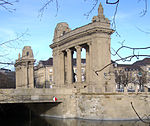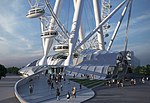Hansaviertel
Berlin geography stubsLocalities of BerlinMitte

The Hansaviertel (German: [ˈhanzaˌfɪʁtl̩] (listen)) is the smallest Ortsteil (district) of Berlin and is between Großer Tiergarten and the Spree River, within the central Mitte borough of Berlin. The district was almost completely destroyed during World War II but was rebuilt from 1957 to 1961 as a social housing project by international master architects such as Alvar Aalto, Egon Eiermann, Walter Gropius, Oscar Niemeyer, and Sep Ruf. Called Interbau, the whole ensemble has two churches (St. Ansgar and Kaiser-Friedrich-Gedächtniskirche). It is now protected as a historic monument.
Excerpt from the Wikipedia article Hansaviertel (License: CC BY-SA 3.0, Authors, Images).Hansaviertel
Klopstockstraße, Berlin
Geographical coordinates (GPS) Address Nearby Places Show on map
Geographical coordinates (GPS)
| Latitude | Longitude |
|---|---|
| N 52.516666666667 ° | E 13.338888888889 ° |
Address
Klopstockstraße 23
10557 Berlin
Germany
Open on Google Maps











